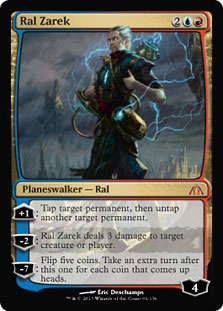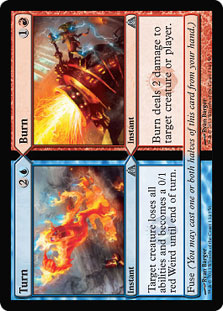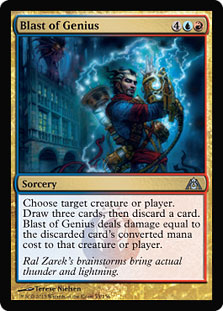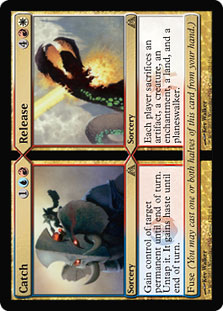Flip five coins?
Look, say what you will, but Ral Zarek’s ultimate has the potential to lead to some pretty exciting moments. Frenetic Efreet was annoying because of how frequently you had to flip coins (often determining the outcome of the match) and how all or nothing flips could be (Bolting one and having them win the flip was extremely frustrating, as it felt like your play was worthless).
Watching a Pro Tour Top 8 and seeing turn after turn of coin flips to determine which Plows and Bolts doesn’t strike me as being that entertaining. Conversely, I’m picturing a Top 8 where Nassif ultimates his Ral Zarek against Brian Kibler while Kibler has a lethal threat on the table. Picture the tension of each coin flip, the excitement. How many turns will Nassif have to find an answer or to just win the race?
What if Nassif had no answers or threats left in his deck, just a Ral Zarek at eight counters, while Kibler is at six life? Ral Zarek, like Liliana of the Veil, is the type of walker that is often worth waiting on the ultimate for a turn in order to keep it. Now, Nassif has at least one road to victory… Take five turns in a row, ticking up Ral Zarek three times, and then Bolting Kibler twice!
Unlikely? Absolutely. He is only slightly better than 3% to actually get there. I’ll tell you what though, each flip (while he is live) is going to be electrifying. Reminds me of another time Nassif was drawing pretty slim.
Of course, we wouldn’t want every match to come down to such heavy-handed variance, but we’re talking about a planeswalker ultimate (making it already somewhat rare), and flipping to see just how many extra turns you are going to take is a bit different than flipping one coin to see if your removal spell did anything.
When you ultimate Ral Zarek, you may already have the game won (in which case it doesn’t matter), but if you don’t at least you can give yourself a chance. While it is random how many turns you end up with, it is not unknown. It’s also not evenly distributed.
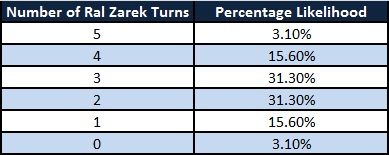
Coin flip cards can be a ton of fun and are beloved by many, but they are certainly not everyone’s favorite since they are among the most overt and artificial feeling forms of variance in the game. This feeling stems from Magic’s inherent system of variance being the use of cards in a random order. That’s a huge amount of randomness, but we have already accepted it.
Variance is fun, but the visibility of variance can be unfun to many people. What is the difference between a coin flip and needing to “draw any creature” when 50% of the cards in your deck are creatures? The odds are the same, but the coin flip feels artificial, external.
This is not an indictment of coin flip cards. Far from it! Rather, this is meant to give insight into why one may feel a bias against coin flip cards, as understanding this bias (and if we experience it) can help us to be able to evaluate a coin flip card rationally. Some love the coin flips, others loathe them, but if we are true spikes that want to win, we should be willing to use coin flip cards if and when they give us the best chance to win.
Coin flip cards are frequently controversial and not everyone agrees on their relative merits, but most of what’s going on with Ral Zarek has nothing to do with coin flips and even the coin flip ability involves flipping five coins which actually smooths out the variance. Imagine if you just flipped a coin to see if you took five turns or zero!
This is all fascinating, but how strong is Ral Zarek really?
One of the most challenging puzzles a new Magic set offers is figuring out the true power level of its planeswalkers and where they belong. While planeswalkers are always at least “decent” and always find at least one home, people hold them to a very different standard than other card types.
One powerful technique for card evaluation is comparing a card to an existing card that we have already formed conclusions about. The card that most clearly begs the comparison to Ral Zarek is Ajani Vengeant.
- Both cost 2CD
- Both have a +1 ability that effectively taps something
- Both have a -2 ability that deals three damage
- Both have a -7 ability with a big impact that doesn’t win the game automatically
That’s a lot in common, but let’s take a closer look at the differences. First, the difference in color is minor, but the truth is that being blue is a small advantage.
What’s better, locking down something that was already tapped or getting both halves of a Twiddle? In terms of raw power level, they are very close, perhaps with a small edge to Ral Zarek. Contextually, though, I think Ajani Vengeant has to get the edge here. Ral Zarek is a mana source and can give a creature effective vigilance (which can protect him in a way), but the ability to lock down an opposing threat is exactly what a planeswalker wants to be able to do. Ajani Vengeant keeps a creature tapped on both your turn and your opponent’s, while Ral Zarek ensures they can use it during each of their own turns.
Ajani Vengeant’s +1 ability is a pretty effective Icy Manipulator, able to deny mana or keep a threat locked down. Ral Zarek’s +1 ability is at least a Reflecting Pool, but in order to get full value out of it, we need to actually want to tap blockers. This is not super conducive to the default Planeswalker play pattern, nor does it protect him (and abilities that let a planeswalker protect itself are generally better than they would be elsewhere). That said, a lot of planeswalkers get used in a lot decks that don’t take full advantage of all of their abilities. Ral Zarek might be good in a control deck but great in an aggressive deck, for instance.
Lightning Helix versus Lightning Bolt is no contest, of course, but Ral Zarek has one very major advantage over Ajani Vengeant. A starting loyalty of four means you can just Bolt twice in back-to-back turns. Generally, I’d rather than an Ajani Vengeant with one loyalty than a Ral Zarek with two, but Ral can get down to business faster if you just want to let the bolts fly. While this ability is the most clearly weaker than Ajani Vengeant of all of his abilities, it is this ability combined with the ability to make mana that I think really makes the card. Two Lightning Bolts for four mana is a good deal even if we have to wait on one, and it gets better from there because we have other options.
Finally, we come to Ral’s ultimate. As we saw above, about a third of the time, we get a Time Stretch. About a third of the time, we get an extra turn more than a Time Stretch. About a third of the time, we get the rest of the options (with one and four turns being five times as likely as zero or five). How much is that worth?
While Ral Zarek’s ability is generally more powerful than casting Time Stretch, the marginal utility of a fifth turn over a fourth is generally not as great as the first extra turn over zero. It’s kind of like asking how much damage we’d do on the average with a card that has a 1% chance of dealing 1000 damage. While we do an average of about ten damage, we would much rather have a card that does a guaranteed ten damage since the 21st point of damage is worth way less than the twentieth and almost all of the 1000 damage is pretty silly overkill. Of course, a few extra turns is not nearly as absurd amount of overkill as this ridiculous example, but there is generally diminishing returns to extra turns.
I think Ajani wins the -7 ability contest because I imagine the number of games where blowing up all of your opponent’s land changes the outcome of the game to be higher than the number of games where taking 5d2-5 turns changes the outcome. It is worth noting that Ral Zarek can ultimate the fourth turn he is in play, while Ajani needs five turns.
If only we knew a place to get five turns…
So all of Ajani Vengeant’s abilities are better than Ral Zarek’s? Yeah, and guess what—Ajani Vengeant is a better card despite Ral Zarek’s four loyalty. Ajani Vengeant isn’t a realistic bar, though. He is one of the five strongest planeswalkers of all-time. Besides, Ral Zarek has one other extremely big advantage over Ajani.
He’s legal.
How good Ral Zarek turns out to be is going to hinge on a few variables.
- How many creatures do people play that you want to deal three damage to?
- Is there a deck that wants a planeswalker and also wants to clear blockers out of the way?
- Is there anything good to untap besides land and creatures you want to give vigilance to?
- How punishing is Ral Zarek to opponents that can’t remove him?
If full of creature removal but struggles against a resolved turn 4 Ral Zarek gets hit by his ultimate, it’s going to be a problem. After all, if you wait until the fifth turn so that Ral lives, you are not just drawing some extra cards and getting extra attacks. Your opponent’s mana isn’t untapping between your turns, so they could get real bottlenecked. It’s like your creatures have haste! Besides, during each of your extra turns, Ral Zarek is gaining more loyalty…
Five extra turns and Ral Zarek is threatening to ultimate again next turn!
Speaking to the point about finding something worth untapping, we don’t exactly have any Time Vaults, but we do have some options. The first one that comes to mind is Izzet Staticaster. Staticaster can already lock out one-drops, but with Ral Zarek he can completely lock out two-drops (a much larger swath, to be sure).
Creatures (8)
Planeswalkers (6)
Lands (26)
Spells (20)

Ok, so I started this list much the same way I start a lot of lists.
I wrote the word Grixis and then started writing cards underneath it.
Unfortunately, I ran into the same problem I always encounter these days. Eventually, it’s time to find a sweeper, and I have to play the game of choosing between tier 2 options like Rolling Temblor, Blasphemous Act, Magmaquake, and Damnation (tier 2 once it destroys the mana base). Supreme Verdict and Terminus are so good!
Of course, it is at this point that I can’t help but take a good hard look at those Dreadbores, those Alchemies, those edicts, and Olivia…
… And compare them to Sphinx’s Revelation.
There are a number of Sphinx’s Revelation hate cards in Dragon’s Maze, so maybe the scale will be tipped, but so far it is just hard to imagine getting away from Sphinx’s Revelation in a control deck.
Rather than go down the well-worn path of full on embracing of white, I decided with this one to try the U/R splash Sphinx’s Revelation approach. I am not super optimistic about its prospects since Azorius Charm is calling pretty loudly to me, but at least Izzet Staticaster + Ral Zarek is a legit plan to make up for no sweepers. It doesn’t address the weakness to Geist of Saint Traft, but it remains to be seen how popular of a card that is and there are answers if we want them. Rolling Temblor is cute in that it doesn’t kill our Staticasters (and combines with them to kill bigger dudes).
Aetherling is an interesting new victory condition that I could see appearing as a one-of in a lot of control decks. It doesn’t take over a game as well as Olivia, but it definitely succeeds as an unkillable threat that can win a game very quickly. It is just so expensive (being a functional seven-drop that eats up all of your mana) that it’s hard to play very many. There have been a lot of Morphling variants over the years, most of which have fallen flat. This one is pretty true to Morphling’s original vision and has updates that look like they are for the better. It’s not clear if we are really in the market for an expensive but super reliable victory condition, but I’d like to think we are.
Turn // Burn is a little slow. It is nice to have solid answers to Thragtusk (since he loses the leaves play trigger), but they are still ahead the five life. With so many ways to ping, having a couple actual hard removal spells can be nice, though.
A card I considered but ultimately removed from this list was another Ral Zarek card, Blast of Genius.
As a card drawer, Blast of Genius actually has a passable rate and could potentially help justify a control deck without Sphinx’s Revelation. Think of it as a Concentrate but one of the cards you draw is a two mana burn spell. You are usually going to get more than two mana’s worth of value out of the burn spell, but you do have cast the card for six, not four.
What’s really interesting about Blast of Genius is tinkering with ways to put expensive cards in our deck that we may want to discard. Sure, we could discard Worldspine Wurm, but that’s a pretty bad card to draw when we don’t have Blast of Genius. Finding ways to be able to play with expensive cards we really want is where the real action is.
Blasphemous Act is the first such card that comes to mind, offering a potential nine points of damage despite effectively being anything but a nine cost spell. There is another way to cheat the system, though.
Split cards.
When you discard a split card to Blast of Genius, it adds up both halves!
A quick search through all of the new split cards to find the highest combined cost…
So much for not playing Sphinx’s Revelation.
Catch // Release is one of the best new split cards, and it has the highest combined casting cost. I guess U/W/R it is:
Creatures (8)
Lands (25)
Spells (27)

This list looks like it’s going somewhere better than the previous, though the real question is how good is a six mana deal nine + Sift.
Catch // Release is a powerful tool but is a little tricky to use. It interferes with Detention Sphere, planeswalkers, and creature-based victory conditions. That said, it is a fantastic answer to planeswalkers and is generally going to have utility against everyone.
Once we are Blasphemous Acting, we might want to try Boros Reckoner, possibly with a Harvest Pyre element. Boros Charm is a long shot, but it obviously combines with Reckoner and Azorius Charm for infinite life and four to the face is a lot more appealing when we are playing six mana spells that send nine to the dome.
Blast of Genius is a pretty sweet new build around, but it is not without counter play. Slaughter Games is pretty devastating, and the new Lobotomy-Twist, Reap Intellect, looks pretty good, too.
As for Ral Zarek, himself, I kind of imagine him seeing moderate success as a random one- or two-of in some U/R/x control decks, but more interestingly, I imagine someone building a new kind of blue aggro or midrange deck that actually takes advantage of Ral Zarek’s ability to remove blockers or do six to the face.
Creatures (23)
- 4 Stromkirk Noble
- 3 Hellrider
- 2 Lightning Mauler
- 2 Rakdos Shred-Freak
- 4 Ash Zealot
- 4 Rakdos Cackler
- 4 Boros Reckoner
Planeswalkers (3)
Lands (22)
Spells (12)

Of course, Mono-Red Aggro variants are far from the only way to go, and I actually think the more likely success will be some new attacking deck that is a little more midrangey, possibly even using Izzet Staticaster. Ral Zarek is a sweet enough card that a proper home that takes full advantage of him has to emerge.
Verdict: Hit, though not a homerun.
What is the best card in Standard to untap besides a land or a Staticaster?
What would a new U/R/x aggro deck look like? Might it use Geist of Saint Traft?
How much do cards like Notion Thief and Reap Intellect impact Sphinx’s Revelation?
Dragon’s Maze only has 146 new cards, but we’re looking at a pretty big impact. There are so many cards that look like they will shake up all of the standard lines of play. It’s like there are half a dozen Great Sable Stags in this set, plus a number of powerful new cards that help strategies that weren’t quite at the top.
There is nothing quite like brewing for a new format.
See you next week!
Patrick Chapin
“The Innovator”

